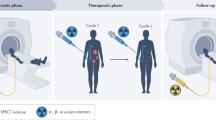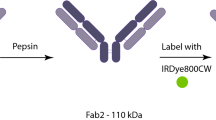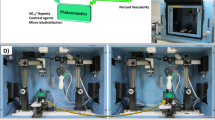Abstract
Gene therapy of cancer has been one of the most exciting and elusive areas of scientific and clinical research in the past decade. One of the most critical issues for ensuring success of this therapy is the development of technology for noninvasive monitoring of the location, magnitude and duration of vector-mediated gene expression, as well as the distribution and targeting of vector particles in vivo. In recent years many advances have been made in high-resolution, in vivo imaging methods, including: radionuclide imaging, such as positron emission tomography (PET) and single photon emission tomography (SPECT), magnetic resonance (MR) imaging and spectroscopy, bioluminescence imaging and various fluorescence imaging techniques, including fluorescence-mediated tomography (FMT) and near-infrared fluorescence (NIRF) reflectance imaging. A variety of factors determine the choice of specific imaging system, some of them are the imaging requirements (single or repeated), intended use (animal or human) and spatial requirements (organs versus cellular resolution and depth). This review provides descriptions of modalities applicable to imaging different parameters of vector-mediated gene expression in tumors and stem cell tracking in vivo.
This is a preview of subscription content, access via your institution
Access options
Subscribe to this journal
Receive 12 print issues and online access
$259.00 per year
only $21.58 per issue
Buy this article
- Purchase on Springer Link
- Instant access to full article PDF
Prices may be subject to local taxes which are calculated during checkout







Similar content being viewed by others
References
Weissleder R, Mahmood U . Molecular imaging. Radiology 2001; 219: 316–333.
Bogdanov Jr A, Weissleder R . The development of in vivo imaging systems to study gene expression. Trends Biotechnol 1998; 16: 5–10.
Blasberg RG, Tjuvajev JG . Herpes simplex virus thymidine kinase as a marker/reporter gene for PET imaging of gene therapy. Q J Nucl Med 1999; 43: 163–169.
Saito Y et al. Quantitative autoradiographic mapping of herpes simplex virus encephalitis with a radiolabeled antiviral drug. Science 1982; 217: 1151–1153.
Tjuvajev JG et al. Imaging the expression of transfected genes in vivo. Cancer Res 1995; 55: 6126–6132.
Gambhir SS et al. Imaging adenoviral-directed reporter gene expression in living animals with positron emission tomography. Proc Natl Acad Sci USA 1999; 96: 2333–2338.
Reader AJ, Zweit J . Developments in whole-body molecular imaging of live subjects. Trends Pharmacol Sci 2001; 22: 604–607.
Herholz K, Weinherd K, Weiss WD . Validity of PET studies in brain tumors. Cerebrovasc Brain Metab Res 1990; 2: 240–265.
Price P . PET as a potential tool for imaging molecular mechanisms of oncology in man. Trends Mol Med 2001; 7: 442–446.
Gambhir S . Molecular imaging of cancer with positron emission tomography. Nat Rev Cancer 2002; 2: 683–693.
Jacobs AH et al. Molecular imaging of gliomas. Mol Imaging 2002; 1: 309–335.
Jacobs AH et al. Non-invasive assessment of vector-mediated gene expression in a phase I/II clinical glioma gene therapy trial by positron emission tomography. Lancet 2001; 358: 727–729.
Jacobs A et al. Positron emission tomography-based imaging of transgene expression mediated by replication-conditional, oncolytic herpes simplex virus type 1 mutant vector in vivo. Cancer Res 2001; 61: 2983–2995.
Jacobs AH et al. Improved herpes simplex virus type 1 amplicon vectors for proportional coexpression of positron emission tomography marker and therapeutic genes. Hum Gene Ther 2003; 14: 277–297.
Gambhir SS et al. A mutant herpes simplex virus type 1 thymidine kinase reporter gene shows improved sensitivity for imaging reporter gene expression with positron emission tomography. Proc Natl Acad Sci USA 2000; 97: 2785–2790.
Filetti S et al. Sodium/iodide symporter: a key transport system in thyroid cancer cell metabolism. Eur J Endocrinol 1999; 141: 443–457.
Boland A et al. Adenovirus-mediated transfer of the thyroid sodium/iodide symporter gene into tumors for targeted radiotherapy. Cancer Res 2000; 60: 3483–3492.
Spitzweg C et al. In vivo sodium iodide symporter gene therapy of prostate cancer. Gene Therapy 2001; 8: 1524–1531.
Haberkorn U . Gene therapy with sodium/iodide symporter in hepatocarcinoma. Exp Clin Endocrinol Diabetes 2001; 109: 60–62.
Huang M et al. Ectopic expression of the thyroperoxidase gene augments radioiodide uptake and retention mediated by the sodium iodide symporter in non-small cell lung cancer. Cancer Gene Ther 2001; 8: 612–618.
Sun X et al. Quantitative imaging of gene induction in living animals. Gene Therapy 2001; 8: 1572–1579.
Liang Q et al. Noninvasive, repetitive, quantitative measurement of gene expression from a bicistronic message positron emission tomography, following gene transfer with adenovirus. Mol Ther 2002; 6: 73–82.
Jacobs A, Breakefield XO, Fraefel C . HSV-1-based vectors for gene therapy of neurological diseases and brain tumors: Part II. Vector systems and applications. Neoplasia 1999; 5: 402–416.
Tjuvajev JG et al. A general approach to the non-invasive imaging of transgenes using cis-linked herpes simplex virus thymidine kinase. Neoplasia 1999; 1: 315–320.
deFelipe P . Polycistronic viral vectors. Curr Gene Ther 2002; 2: 355–378.
Jacobs A et al. Functional co-expression of HSV-1 thymidine kinase and green fluorescent protein: Implications for noninvasive imaging of transgene expression. Neoplasia 1999; 1: 154–161.
Doubrovin M et al. Imaging transcriptional regulation of p53-dependent genes with positron emission tomography in vivo. Proc Natl Acad Sci USA 2001; 98: 9300–9305.
Bogdanov AA, Lewin M, Weissleder R . Approaches and agents for imaging the vascular system. Adv Drug Deliv Rev 1999; 37: 279–293.
Schellingerhout D, Rainov NG, Breakefield XO, Weissleder R . Quantitation of HSV mass distribution in a rodent brain tumor model. Gene Therapy 2000; 7: 1648–1655.
Zalutsky MR et al. Radioiodinated antibody targeting of the HER-2/neu oncoprotein: effects of labeling method on cellular processing and tissue distribution. Nucl Med Biol 1999; 26: 781–790.
Zinn KR et al. Detection and measurement of in vitro gene transfer by gamma camera imaging. Gene Therapy 2001; 8: 291–299.
Raben D et al. Enhancement of radiolabeled antibody binding and tumor localization through adenoviral transduction of the human carcinoembryonic antigen gene. Gene Therapy 1996; 3: 567–580.
Bogdanov Jr AA, Simonova M, Weissleder R . Engineering membrane proteins for nuclear medicine: applications for gene therapy and cell tracking. Q J Nucl Med 2000; 44: 224–235.
Simonova M, Wall A, Weissleder R, Bogdanov Jr AA . Tyrosinase mutants are capable of prodrug activation in transfected nonmelanotic cells. Cancer Res 2000; 60: 6656–6662.
Kim YS et al. Tc-99 m MIBI SPECT is useful for noninvasively predicting the presence of MDR1 gene-encoded P-glycoprotein in patients with hepatocellular carcinoma. Clin Nucl Med 1999; 24: 874–879.
Weissleder R . Scaling down imaging: molecular mapping of cancer in mice. Nat Rev Cancer 2002; 2: 11–18.
Allport JR, Weissleder R . In vivo imaging of gene and cell therapies. Exp Hematol 2001; 29: 1237–1246.
Weissleder R et al. In vivo magnetic resonance imaging of transgene expression. Nat Med 2000; 6: 351–355.
Zimmer C et al. Tumor cell endocytosis (TCE) imaging facilitates delineation of the glioma–brain interface. Exp Neurol 1997; 143: 61–69.
Moore A et al. Human transferrin receptor gene as a marker gene for MR imaging. Radiology 2001; 221: 244–250.
Ichikawa T et al. MRI of transgene expression: correlation of therapeutic gene expression. Neoplasia 2002; 4: 523–530.
Bogdanov A, Weissleder R . In vivo imaging of gene delivery and expression. Trends Biotechnol 2002; 20: S11–S18.
Weissleder R et al. MR imaging and scintigraphy of gene expression through melanin induction. Radiology 1997; 204: 425–429.
Enochs WS et al. Paramagnetic metal scavenging by melanin: MR imaging. Radiology 1997; 204: 417–423.
Louie AY et al. In vivo visualization of gene expression using magnetic resonance imaging. Nat Biotechnol 2000; 18: 321–325.
Stegman LD et al. Noninvasive quantitation of cytosine deaminase transgene expression in human tumor xenografts with in vivo magnetic resonance spectroscopy. Proc Natl Acad Sci USA 1999; 96: 9821–9826.
Boven E, Hendriks HR, Erkelens CA, Pinedo HM . The anti-tumour effects of the prodrugs N-1-leucyl-doxorubicin and vinglastine-isoleucinate in human ovarian cancer xenografts. Br J Cancer 1992; 66: 1044–1047.
van Haperen VW et al. Regulation of phosphorylation of deoxycytidine and 2′,2′-difluorodeoxycytidine (gemcitabine); effects of cytidine 5′-triphosphate and uridine 5′-triphosphate in relation to chemosensitivity for 2′,2′-difluorodeoxycytidine. Biochem Pharmacol 1996; 51: 911–918.
Blackstock AW et al. Tumor uptake and elimination of 2′,2′-difluoro-2′-deoxycytidine (gemcitavine) after deoxycytidine kinase gene transfer: correlation with in vivo tumor response. Clin Cancer Res 2001; 7: 3263–3268.
Lewin M et al. Tat peptide-derivatized magnetic nanoparticles allow in vivo tracking and recovery of progenitor cells. Nat Biotechnol 2000; 18: 410–414.
Josephson L, Perex M, Weissleder R . Magnetic nanosensors for the detection of oligonucleotide sequences. Angew Chem (Int Ed) 2001; 40: 3204–3206.
Chalfie M et al. Green fluorescent protein as a marker for gene expression. Science 1994; 263: 802–805.
Gerdes HH, Keather C . Green fluorescent protein: applications in cell biology. FEBS Lett 1996; 389: 44–47.
Ellenberg J, Lippincott-Schwartz J, Presley JF . Dual-colour imaging with GFP variants. Trends Cell Biol 1999; 9: 52–56.
Chaudhuri TR et al. A noninvasive reporter system to image adenoviral-mediated gene transfer to ovarian cancer xenografts. Gynecol Oncol 2001; 83: 432–438.
Ilyin SE, Flynn MC, Plata-Salaman CR . Fiber-optic monitoring coupled with confocal microscopy for imaging gene expression in vitro and in vivo. J Neurosci Methods 2001; 108: 91–96.
Jain RK, Munn LL, Fukumura D . Dissecting tumour pathophysiology using intravital microscopy. Nat Rev Cancer 2002; 2: 266–276.
Tsuzuki Y et al. Vascular endothelial growth factor (VEGF) modulation by targeting hypoxia-inducible factor-1alpha–> hypoxia response element–> VEGF cascade differentially regulates vascular response and growth rate in tumors. Cancer Res 2000; 60: 6248–6252.
Kadambi A et al. Vascular endothelial growth factor (VEGF)-C differentially affects tumor vascular functions and leukocyte recruitment: role of VEGF-receptor 2 and host VEGF-A. Cancer Res 2001; 61: 2402–2408.
Yuan F et al. Time-dependent vascular regression and permeability changes in established human tumor xenografts induced by an anti-vascular endothelial growth factor/vascular permeability factor antibody. Proc Natl Acad Sci USA 1996; 93: 14765–14770.
Lubiatowski P et al. Gene therapy by adenovirus-mediated vascular endothelial growth factor and angiopoietin-1 promotes perfusion of muscle flaps. Plast Reconstr Surg 2002; 110: 149–159.
Hoshida T et al. Gene therapy for pancreatic cancer using an adenovirus vector encoding soluble flt-1 vascular endothelial growth factor receptor. Pancreas 2002; 25: 111–121.
Li Y et al. The role of selectins and integrins in adenovirus vector-induced neutrophil recruitment to the liver. Eur J Immunol 2002; 32: 3443–3452.
Becker A et al. Receptor-targeted optical imaging of tumors with near-infrared fluorescent ligands. Nat Biotechnol 2001; 19: 327–331.
Tung C, Bredown S, Mahmood U, Weissleder R . Preparation of a cathepsin D sensitive near-infrared fluorescence probe for imaging. Bioconjugate Chem 1999; 10: 892–896.
Weissleder R, Tung C-H, Mahmood U, Bogdanov Jr A . In vivo imaging of tumors with protease-activated near-infrared fluorescent probes. Nat Biotech 1999; 17: 375–378.
Tung CH, Mahmood U, Bredow S, Weissleder R . In vivo imaging of proteolytic enzyme activity using a novel molecular reporter. Cancer Res 2000; 60: 4953–4958.
Marten K et al. Detection of dysplastic intestinal adenomas using enzyme-sensing molecular beacons in mice. Gastroenterology 2002; 122: 406–414.
Bremer C, Tung CH, Weissleder R . In vivo molecular target assessment of matrix metalloproteinase inhibition. Nat Med 2001; 7: 743–748.
Shah K et al. In vivo imaging of HIV protease activity in amplicon vector transduced gliomas. Cancer Res 2004; 64: 273–278.
Ntziachristos V, Tung CH, Bremer C, Weissleder R . Fluorescence molecular tomography resolves protease activity in vivo. Nat Med 2002; 8: 757–760.
Contag CH, Ross BD . It's not just about anatomy: in vivo bioluminescence imaging as an eyepiece into biology. J Magn Reson Imaging 2002; 16: 378–387.
Contag CH et al. Use of reporter genes for optical measurements of neoplastic disease in vivo. Neoplasia 2000; 2: 41–52.
Wu JC, Sundaresan G, Iyer M, Gambhir SS . Noninvasive optical imaging of firefly luciferase reporter gene expression in skeletal muscles of living mice. Mol Ther 2001; 4: 297–306.
Sweeney TJ et al. Visualizing the kinetics of tumor-cell clearance in living animals. Proc Natl Acad Sci USA 1999; 96: 12044–12049.
Contag CH et al. Photonic detection of bacterial pathogens in living hosts. Mol Microbiol 1995; 18: 593–603.
Shah K, Tang Y, Breakefield X, Weissleder R . Real-time imaging of TRAIL-induced apoptosis of glioma tumors in vivo. Oncogene 2003; 22: 6865–6872.
Ntziachristos V, Kreis R, Boesch C, Quistorff B . Dipolar resonance frequency shifts in 1H MR spectra of skeletal muscle: confirmation in rats at 4.7 T in vivo and observation of changes postmortem. Magn Reson Med 1997; 38: 33–39.
Rehemtulla A et al. Molecular imaging of gene expression and efficacy following adenoviral-mediated brain tumor gene therapy. Mol Imaging 2002; 1: 43–55.
Iyer M et al. Two-step transcriptional amplification as a method for imaging reporter gene expression using weak promoters. Proc Natl Acad Sci USA 2001; 98: 14595–14600.
Aboody KS et al. Neural stem cells display extensive tropism for pathology in adult brain: evidence from intracranial gliomas. Proc Natl Acad Sci USA 2000; 97: 12846–12851.
Ourednik J et al. Neural stem cells display an inherent mechanism for rescuing dysfunctional neurons. Nat Biotechnol 2002; 20: 1103–1110.
Snyder EY et al. Multipotent neural cell lines can engraft and participate in development of mouse cerebellum. Cell 1992; 68: 33–51.
Snyder EY, Taylor RM, Wolfe JH . Neural progenitor cell engraftment corrects lysosomal storage throughout the MPS VII mouse brain. Nature 1995; 374: 367–370.
Herrlinger U et al. Neural precursor cells for delivery of replication-conditional HSV-1 vectors to intracerebral gliomas. Mol Ther 2000; 1: 347–357.
Lynch WP, Sharpe AH, Snyder EY . Neural stem cells as engraftable packaging lines optimize viral vector-mediated gene delivery to the CNS: evidence from studying retroviral env-related neurodegeneration. J Virol 1999; 73: 6841–6851.
Tang Y et al. In vivo tracking of neuronal progenitor cell migration to glioblastomas. Hum Gene Ther 2003; 14: 1247–1254.
Bhaumik S, Gambhir SS . Optical imaging of Renilla luciferase reporter gene expression in living mice. Proc Natl Acad Sci USA 2002; 99: 377–382.
Laxman B et al. Noninvasive real-time imaging of apoptosis. Proc Natl Acad Sci USA 2002; 99: 16551–16555.
Goldstein DJ, Weller SK . Herpes simplex virus type 1-induced ribonucleotide reductase activity is dispensable for virus growth and DNA synthesis; isolation and characterization of an ICP6 lacZ insertion mutant. J Virol 1988; 62: 196–205.
Author information
Authors and Affiliations
Rights and permissions
About this article
Cite this article
Shah, K., Jacobs, A., Breakefield, X. et al. Molecular imaging of gene therapy for cancer. Gene Ther 11, 1175–1187 (2004). https://doi.org/10.1038/sj.gt.3302278
Published:
Issue Date:
DOI: https://doi.org/10.1038/sj.gt.3302278
Keywords
This article is cited by
-
Use of Molecular Imaging in Clinical Drug Development: a Systematic Review
Nuclear Medicine and Molecular Imaging (2019)
-
Photonic monitoring of treatment during infection and sepsis: development of new detection strategies and potential clinical applications
Analytical and Bioanalytical Chemistry (2018)
-
Multiplexed imaging for diagnosis and therapy
Nature Biomedical Engineering (2017)
-
Imaging techniques: new avenues in cancer gene and cell therapy
Cancer Gene Therapy (2017)
-
Molecular Imaging of Stem Cells and Exosomes for Myocardial Regeneration
Current Cardiovascular Imaging Reports (2017)



